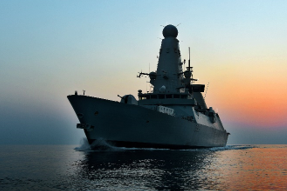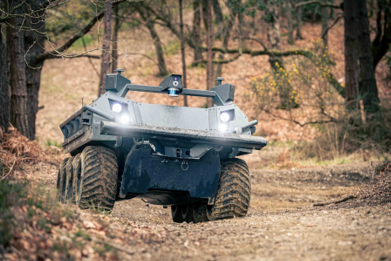DE&S 2025 - Delivering the edge through people, technology, and innovation
Category: Recruitment
Publish date: 30/06/2021
 Spotlight on Sonar Systems Engineering
Spotlight on Sonar Systems Engineering
Sonar systems engineering – also known as underwater acoustic systems engineering – is a highly specialised team within Defence Equipment & Support (DE&S).
What is Sonar?
Sonar is short for Sound Navigation and Ranging, and is the technology that allows ships and submarines to navigate, communicate and detect objects underwater. The principle is that ultrasonic sound waves are transmitted towards the seabed, and technology is used to measure the time it takes for the sound pulses to be reflected back to the transducer - sound waves can travel for hundreds of miles underwater. Sonar tends to fall into two main categories: passive (used for listening) and active (emitting pulses and listening for resultant echoes).
 Why is Sonar important?
Why is Sonar important?
Sonar is extremely useful for exploring and mapping the underwater world, as sound waves travel further underwater compared to radar and light waves. It allows for the detection of objects underwater, such as submarines, or icebergs.
Where did it begin?
Inserting a tube into water to try and detect the sound of vessels beneath the surface, Leonardo da Vinci is recorded as having implemented the first iteration of Sonar in 1490. In Switzerland in 1822, physicist Jean-Daniel Colloden used an underwater bell to find the calculations of the speed of sound underwater. The first registered Sonar-style device was invented by naval architect Lewis Nixon in 1906, as a way to detect icebergs. Sonar systems were then significantly developed during WWI, in response to the growing threat of submarine warfare. In 1915, French physicist Paul Langevin and Russian engineer Constantin Chilowski developed the first active Sonar device for detecting submarines.
What opportunities are there in Sonar?
We have on-going opportunities to join us as a Sonar Systems Engineer, which sits within the Underwater and Electronic Warfare (UEW) team. UEW has around 30 active projects at any one time and establishes future support arrangements as well as the delivery of new capabilities. The UEW equipment portfolio includes Sonar and Sensor systems, Visual systems, and Mine Neutralisation and Exploitation.
UEW also provides in-service support on a large scale, with upward of 30 support contracts. These are delivered through four sections: Capability Development, Sensors, Underwater Warfare and Anti-Submarine Warfare. Sonar Systems Engineers sit within the Underwater portfolio and utilise the 'Spearhead principle'. This is to seek work within an agile framework by accelerating design, development, test, evaluation, trials and acceptance of capability - delivering the best solutions into service, at pace.
Applicants for this position should have in-depth, practical experience and a strong understanding of Sonar principles; including evidence of setting technical requirements during the acquisition lifecycle, and integrating engineering solutions into complex systems.
 What’s it like working at DE&S?
What’s it like working at DE&S?
Having joined the Royal Navy in 1980 as a mechanic and later progressing into a specialised career in Sonar, Ian Hurst now works as a Naval Applicator ensuring capability is achieved at all times, from minor to mainframe Sonars on all classes of vessel. We asked him what makes DE&S a great place to work:
“In my opinion, joining DE&S was to give the Royal Navy the full support they require to ensure optimum advice and information when they require. The ability to talk about any issues to any level of personnel within our Abbey Wood HQ [in Bristol] is one of the best things; advice is everywhere, and everyone is always able to answer or point you in the right direction […] Since I’ve been with DE&S, I’ve undertaken many training courses. Full support and time are always given to everyone if you wish to progress, including mentoring. […] Every day is a learning day. And whilst it can present challenges at times, it’s also a fulfilling role and I feel like I have contributed to help the team run efficiently.”
If you’re embarking on the next step in your career, you can find all of our latest opportunities by clicking here.
Revolutionising UK military robotics
The Expeditionary Robotics Centre of Expertise (ERCoE) has recently been launched by DE&S, in collaboration with the British Army. Development of innovative robotic equipment that will give the UK military an operational advantage will be accelerated by this specialist organisation. The ERCoE will bring together robotics and autonomous systems experts from across defence, government, academia and industry – aligning with DE&S’ strategy to deliver the edge through people, technology and innovation.
 Adopting a collaborative and agile-by-design approach, ERCoE will operate from MOD Abbey Wood in Bristol, and from the Army BattleLab in Dorset, with an innovative technology project being announced in August 2020. The ERCoE will act as a focal point for current innovative projects as well as assessing unexplored, high-risk but rapidly maturing technologies.
Adopting a collaborative and agile-by-design approach, ERCoE will operate from MOD Abbey Wood in Bristol, and from the Army BattleLab in Dorset, with an innovative technology project being announced in August 2020. The ERCoE will act as a focal point for current innovative projects as well as assessing unexplored, high-risk but rapidly maturing technologies.
Projects to be investigated at the outset include: Remote Platoon Vehicles, nano Unmanned Air Systems, autonomous resupply of forward troops and how defence forms Human Machine Teams. Open access to information and fresh ideas will ensure defence can exploit the benefits that this key disruptive technology could present, while also facilitating the rapid growth of expertise in this area.
The centre sits under the Future Capability Group (FCG) at DE&S, which has a direct line to market - ensuring ideas can be rapidly developed. FCG Head, James Gavin said:
“The CoE concept was born out of the need and opportunity to bring together separate projects and people into single groupings to be more efficient and effective. Being more effective means a razor-sharp focus on exploitation and operational advantage as the goal. Co-teaming between the Army and DE&S will put the customer at the heart of what we do: exploring and delivering iteratively under an ‘agile by default’ mindset.”
DE&S personnel will work alongside industry experts at the Army BattleLab within the Defence Innovation Centre, allowing new ideas and concepts to be quickly developed and put into practice. The ERCoE has been jointly launched with Future Force Development in Army HQ and is aligned to their Robotics and Autonomous Systems (RAS) Strategy. The hub will initially focus on projects for the British Army, but there is optimism that as the group expands and matures, it will become a central hub of advice for expeditionary robotics across Defence. Lt Col Iain Lamont, SO1 Robotics and Autonomous Systems at the British Army, said:
“The Army’s Future Force Development team are delighted to be entering into a fast-paced and exciting new partnership with the ERCoE. Driven by the Army’s RAS Strategy, this new agile approach will enable the delivery of several exciting new developments, and ensure game-changing technology enters into service as early as possible as we look to accelerate Army transformation.”
The ERCoE launch is a trailblazer within the recently launched DE&S strategy 2025, and will pave the way for future delivery teams to maximise advantage from this novel capability.
DE&S 2025
DELIVERING THE EDGE THROUGH PEOPLE, TECHNOLOGY AND INNOVATION
At DE&S, we have recently launched our new corporate strategy, laying out our vision for 2025 - to be recognised leaders in the delivery of military equipment solutions for the information age.
It ensures we can rise to the challenges set out in the Integrated Review of Security, Defence, Development and Foreign Policy, which describes the government’s vision for the UK’s role in the world over the next decade, and the action government will take to 2025. It will will allow us to seize the opportunities presented in the Defence Command Paper and Defence & Security Industrial Strategy. Our strategy provides a roadmap for our organisation over the next four years so that we can deliver safe, secure and innovative solutions at greater pace. And we’ll achieve this through our five strategic priorities:
PACE AND AGILITY FOR OUR CLIENTS
We will maximise the availability of our operational platforms and systems by implementing optimised support solutions. These will blend state-of-the-art processes with the increased exploitation of data, modelling and artificial intelligence. We’ll improve our ability to deliver performance and solutions at pace by responding faster to emerging priorities. Working ever more closely with our clients, we’ll look for opportunities to pull through new technology and software releases quicker, improve the integration of capabilities across domains, and bring professional expertise and innovation in procurement and support.
VALUE TO THE TAXPAYER AND SOCIETY
We’ll be a more efficient and effective organisation, making our investments go further and providing a positive impact to Defence and the wider community. From helping the Government “build back better” following the Covid-19 pandemic, to promoting jobs, prosperity and exports, we’ll be playing an important role in supporting national priorities. We’ll increase our focus on achieving carbon Net Zero by 2040 in the way we operate and on our estate, while also reducing the carbon emissions of the equipment capabilities we deliver by reducing our reliance on fossil fuels and promoting more sustainable solutions.
DELIVERY THROUGH PEOPLE
Our people are critical to our successes. We’re dependent on their commitment and professionalism and aim to empower our people to help us achieve our mission; nurturing the diversity of skills and experience we need to solve our toughest challenges. We’ll increase opportunities for learning and development, invest in our leaders and new technologies for smarter working, and deliver our Equality, Diversity, Inclusion and Wellbeing Strategy. This will help us create and sustain a culture that will be critical to our success.
ACCELERATED DIGITAL SOLUTIONS
Digital technology is increasingly central to the capabilities we deliver. We will therefore drive digital solutions for business and battlespace advantage. While our traditional focus on large platforms remains critical, we’ll also embrace new ways of integrating systems and data across the battlespace. We’ll pool expertise in cross-cutting specialisms and improve the pull-through of new and emerging technologies into our procurement and support solutions. Advanced business tools, automation and a digitally savvy workforce will transform the way we support capabilities and operate as an organisation.
DELIVERY THROUGH PARTNERS
Our achievements are shared with our partners – in industry and internationally. We’ll attract and work at pace with diverse, resilient and innovative suppliers and partners. We’ll support the implementation of the Defence and Security Industrial Strategy, including adopting a more flexible approach to acquisition based on understanding the markets, the technologies, national security requirements and the prosperity opportunities. We’ll also better understand the supply chains of our critical and priority programmes to ensure that they remain secure. And will work together to protect our equipment and capabilities, as well as the sensitive information and technology that underpin them.
We’re delighted to be working with Career Transition Partnership to provide Service leavers with access to our roles. So, if you think you’d be the right fit for DE&S, please head over to the CTP’s online job portal, RightJob to find our latest vacancies.